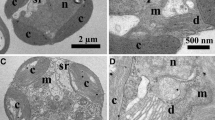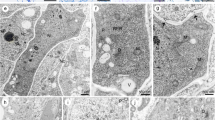Abstract
The wall of the younger sporophorous vesicle (enclosing the sporogogonial plasmodium) of Pleistophora mirandellae Vaney and Conte, 1901 is composed of a membranous labyrinth, about 0.3–0.6 μm high, interwoven with host cell cytoplasm. There is electron-opaque matter within the partitions of the labyrinth. At the onset of plasmotomy, the partitions of the labyrinth become shorter and then possibly due to stretching of the wall and withdrawal of the membranes, the electron-opaque matter is ejected to the lumen side of the wall and the partitions diappear. Only cisterna-like remains of the partitions are observable outside the electron-opaque layer. The thickness of walls in vesicles with ripe spores can be even less than 100 nm.
Similar content being viewed by others
Author information
Authors and Affiliations
Additional information
Received: 15 November 1995 / Accepted: 21 May 1996
Rights and permissions
About this article
Cite this article
Pekkarinen, M. Ultrastructure of the wall of the sporophorous vesicle during sporogony of Pleistophora mirandellae (Protozoa: Microspora). Parasitol Res 82, 740–742 (1996). https://doi.org/10.1007/s004360050195
Issue Date:
DOI: https://doi.org/10.1007/s004360050195




